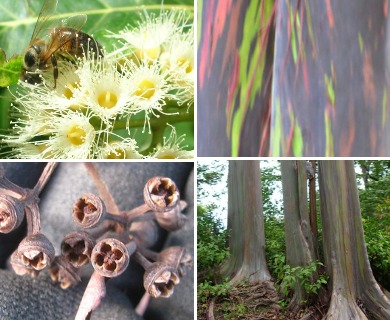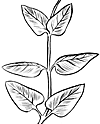Rainbow Eucalyptus
Eucalyptus deglupta
Eucalyptus-Like family (Myrtaceae)
Post-Cook introduction
The beautiful mottled bark of many colors distinguishes this tree and qualifies it as an ornamental for moist regions. It is, however, a rapidly growing tree that reaches enormous size and so must be used with caution as a garden or landscaping tree. The smoothish bark peels in long strips, exposing various shades of pink, purple, copper, brown, orange, and green. Further identified by the broad mostly paired leaves and the numerous small flowers and small half-round Because of its very rapid growth and good wood, this tree is now used in low elevation forest plantations.

©2005 Forest And Kim Starr
Leaves mostly with leaf-stalks of 1⁄2 inch (13 ). Blades are 2–6 inches (5–15 ) long and 1–2 3⁄4 inches (2.5–7 ) wide, long-pointed at rounded or blunt at base, slightly thickened, shiny green, dull and paler beneath, side veins fine and curved. Juvenile leaves stalked, to oblong lance-shaped, 2 inches (5 ) long and 1 1⁄2 inches (4 ) wide, long-pointed, thin.
Flower clusters () and lateral, with flattened branches 2–4 inches (5–10 ) long. Flowers numerous, 3–7 in a group () on slender stalks less than 1⁄4 inch (6 ) long, more than 1⁄2 inch (13 ) across the many spreading white Buds club-shaped, 3⁄16 inch (5 ) long and 1⁄8 inch (3 ) wide, with a conical base and conical pointed lid of equal length. Seed capsules are short-stalked, half-round, 3⁄16 inch (5 ) long and broad, dark brown with thin and 3–4 pointed valves 1⁄16 inch (1.5 ) long, protruding and spreading.
Wood from trees up to 20 years old is pale reddish brown with density, appearance and working characteristics similar to red lauan (Shorea negrosensis Foxworthy) of the Philippines. Wood from older trees is said to be more dense, but the lightweight wood ( gr. 0.45) from young trees in Hawaii has a relatively low shrinkage and no serious growth stress problems in manufacturing. It is suited for a wide range of uses in furniture and construction.
Used elsewhere for construction, cabinet work, and boat building.
This species was introduced to Hawaii at Wahiawa Botanic Garden in 1929 from the Philippines. Only 4,000 trees had been planted in the forest reserves before 1960, but since then E. deglupta has been used extensively, and several New Guinea and New Britain races have been introduced. Trees may be seen also at the Hilo State Office Building (where they had to be topped for safety 3 or 4 years after planting), next to Hamilton Library on the University of Hawaii campus, and at numerous other locations. The bark makes the tree easily recognizable.
Special areas
Keahua, Wahiawa, Foster, Waiakea
Champion
Height 86 ft (26.2 ), c.b.h. 6.5 ft (2.0 ), spread 42 ft (12.8 ). Wahiawa Botanical Garden, Wahiawa, Oahu (1968).
Range
Philippine Islands (Mindanao), Moluccas, New Guinea, and New Britain. Wet lowland tropics or tropical rain forests.
Other common names
Mindanao-gum, NewGuinea-gum, amammanit eucalyptus; kamarere (Papua-New Guinea)
Botanical
Eucalyptus naudiniana F. Muell.
This species ranges from New Britain northwestward through Indonesia to Mindanao in the Philippines. It achieves its best growth in pure stands that grow on flood plains along the rivers of New Britain. It is one of only two eucalypts (E. urophylla S. T. Blake is the other) not native to Australia and one of the few native to a tropical rainforest climate.
One of the world’s fastest growing trees, reaching as much as 33 ft (10 ) in less than 18 months. In Hawaii, attaining a height of 100 ft (30 ) in 7 years. A planted stand near Port Moresby, New Guinea, had an average height of 180 ft (54 ) and diameter of 2 ft (0.6 ) at 14 years of age.




